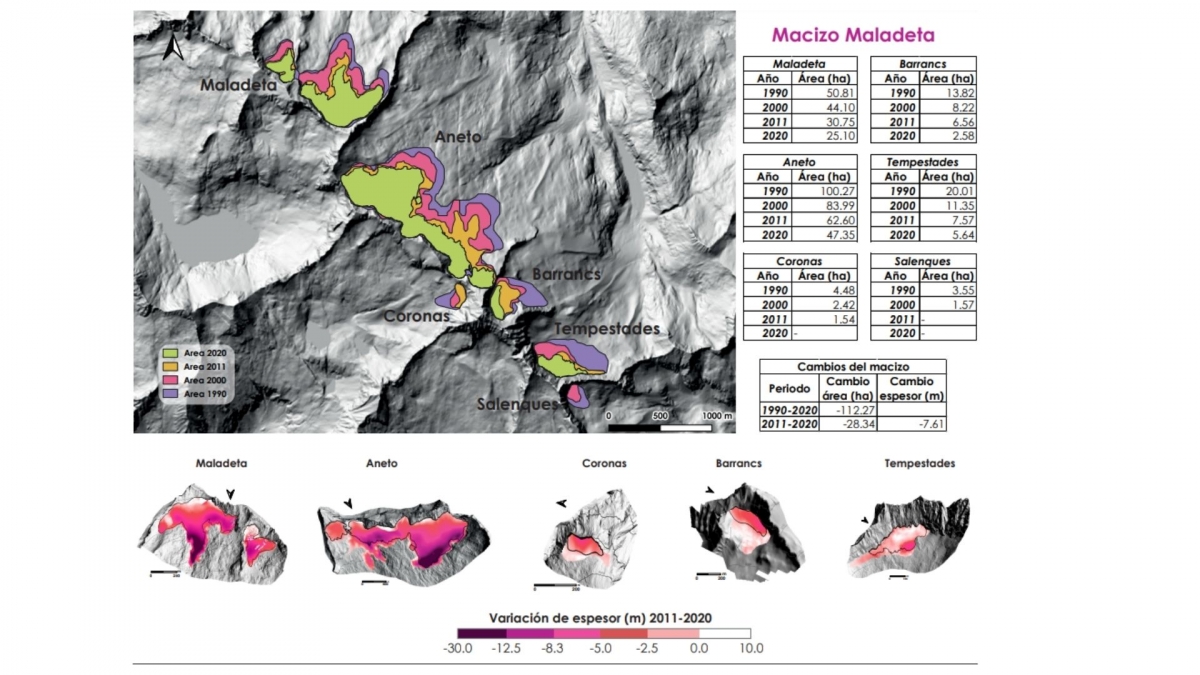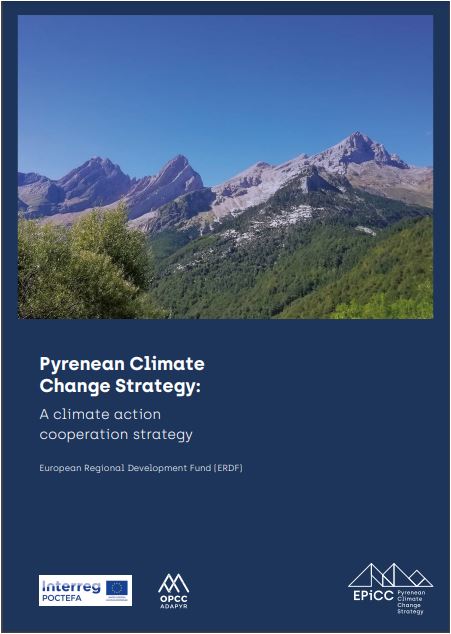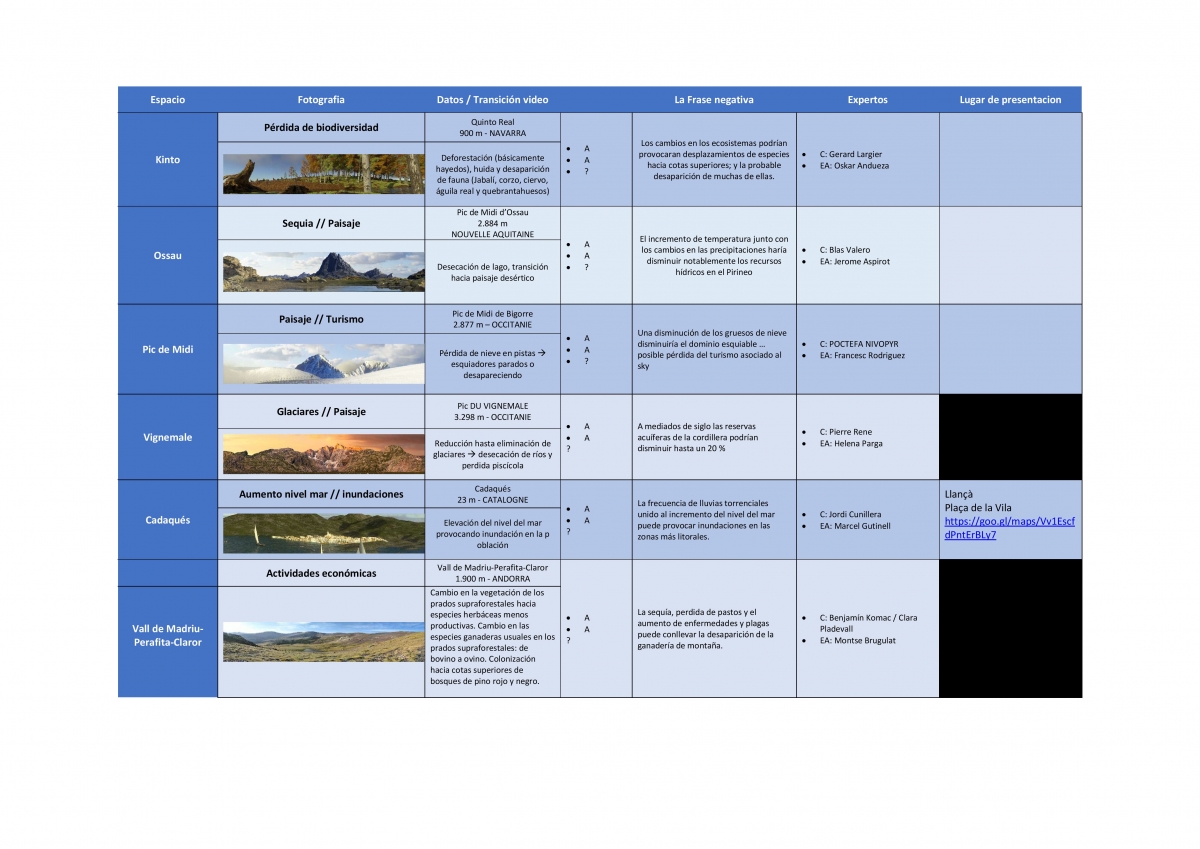Objectives
The main goal of the OPCC ADAPYR objective is to prepare the region for it to better adaptation to climate change and increase its resilience to the challenges it poses. To this end, it has focused on three main lines of action:
1) the OBSERVATION of data on climate change efforts in the key areas of the Pyrenees: water resources, cryosphere, fauna, flora, woodland and natural risks.
2) the CAPITALISATION of available information (projects programmed previously) to reflect it in tools adapted to the specific demands of the different agents in the region.
3) the TRANSFER of knowledge generated in the region, its local agents and the population in general.
To this end, the project has achieved a series of specific objectives to:
- Consolidate the collaborative observation and research work on both sides of the Pyrenees, defining the basic climate change impact indicators.
- Prepare the first Pyrenees Climate Change Strategy, in harmony with the other territorial strategies in this field.
- Transfer knowledge through participative processes that make it possible to identify the information needs and generate key information for the main socioeconomic sectors in the Pyrenees (farming and grazing, tourism, energy, health).
- Search for formulas of collaboration and possible sources of financing to maintain climate change observation networks in the Pyrenees in the long term.
- Communicate and support the decision-making process of the different areas involved.
- Greater visibility for the Pyrenees, the specificities and needs of this region in relation to climate change and globally.
Actions and results
OBSERVATION
Results
- Mapping of actors and technical queries on information needs;
- Formulas for ensuring the monitoring of long-term climate change impact indicators (interviews, surveys and research into the perpetuation of a basic network of indicators and conclusion of collaboration agreements);
- Valuation of the results of the OPCC2 project, projects associated with the 1st and 2nd edition and other Pillar 2 projects scheduled for the 3rd edition of POCTEFA, with more than 250 cartographic layers generated, downloadable from the geoportal.
- Indicator monitoring reports on the impact of climate change on sensitive high mountain ecosystems, such as lakes, peatland and glaciers;
- Revitalisation and monitoring of the Phénoclim and REPLIM science network
Summary and objectives:
The OBSERVATION action responds to the specific objective of improving knowledge of climate change in the Pyrenees: climate fundamentals, weaknesses, impacts and risks in natural and human systems.

The specific goals of this action have been to identify the real needs of agents in the Pyrenees in relation to information on climate change. This has made it possible to select significant indicators in relation to the different areas studied (climate, water resources, cryosphere, fauna, flora, woodland and natural risks) generated by other projects, to capitalise them and make them accessible on the OPCC information portal and geoportal.


On the other hand, this action has helped to maintain basic monitoring of indicators on the impact of climate change on phenology (life cycle of woodland species, flora and fauna), vulnerable ecosystems (lakes, peatland, glaciers) and natural resources (water resources) by monitoring the selected indicators and with support from citizen science actions like Phénoclim.

ADAPYR has also enhances the search for formulas to perpetuate observations in collaboration with the competent authorities for each topic to ensure minimum monitoring of long-term climate change indicators in the mountain range.
Along this line, ADAPYR has entered into bilateral agreements to share climate change data in the CTP region with AEMET, Euskalmet, Météo France, Servei Meteorològic de Catalunya and Servei Meteorològic d’Andorra. In addition to representing a milestone in climate action in the Pyrenees, these agreements make it possible to keep the current cross-border, standardised climate database up to date, for the study of climate change in the Pyrenees.
Conclusions
Adaptation to climate change requires reliable scientific information covering an extensive time line on the impact of this complex phenomenon. To this end, it is necessary to maintain long-term OBSERVATION systems, as they are essential in providing key information for generating and monitoring climate change indicators. The perpetuation of these cross-border observation networks and initiatives, beyond the life time of the projects that led to their creation, is a challenge that forms part of the basis of the OPCC's strategy.
CAPITALISATION
Results:
- Co-creation of the first Pyrenees Climate Change Strategy (EPiCC) based on existing regional policies;
- Guidelines for local climate change planning in the Pyrenees: climate governance from a local to regional scale;
- Guidelines for the integration of adapting to climate change in water management plans;
- Guidelines for preparing adaptive woodland management plans;
- Guidelines for including the adaptation to climate change in Plans for conserving vulnerable flora and fauna;
- Online tool of adaptation recommendations;
- Expanding and assessing best practices in relation to initiatives for adapting to climate change;
- Technical support (13) and experiments (5) on ecologically restoring soil and plant life (ECOVARS) and generating guidelines for multiplying plant species.
Summary and objectives:
The capitalisation action responds to the specific objective of promoting innovation through specific climate change actions, from the capitalisation of results and successful projects. The aim of this action has been to reflect the knowledge acquired on climate change in operational tools that facilitate the decision-making of regions and their socioeconomic agents to promote climate governance and increase resilience. To achieve this objective, the 7 regions of the CTP have developed and approved the first Pyrenees Strategy for Adapting to Climate Change (EPiCC).
Following an extensive participatory process lasting more than 2 years, in which around 400 people have participated, the EPiCC has been consolidated as the cross-border roadmap that brings together the seven Pyrenees regions around five main areas of cooperation in the fight against climate change. This document has established the strategic framework for the development of the long-term OPCC action plan, starting with the development of a 2023-2030 Operating Plan.

Por otro lado, ADAPYR también ha desarrollado herramientas de apoyo y consulta sobre adaptación para las personas tomadoras de decisiones sobre las diferentes temáticas clave en los Pirineos.
Furthermore, ADAPYR has also developed support and consultation tools on adaptation for decision makers in relation to the different key topics in the Pyrenees.
Specifically, within the context of the project, guidelines have been published for adapting to climate change in the resilient management of water resources, guidelines for adaptive woodland management, guidelines for the management and conservation of Pyrenees fauna and flora and guidelines to include the adaptation to climate change in the local planning of Pyrenees towns and cities. As a complementary tool, a search engine of recommendations has been created, providing residents with the main key sectoral recommendations generated by the guidelines, in a digital and interactive format that will be updated over time.

The CAPITALISATION action has also made it possible to develop the OPCC's portal of best practices in adapting to climate change, including 32 new best practices with the corresponding self-explanatory audiovisual capsules.

Aware that putting theory into practice is no mean feat, the aim of this portal is to provide a window for successful adaptation, innovative and replicable adaptation experiences in all regions in the Pyrenees mountain range. The best practices on the portal include the OPCC ADAPYR project, which has supported the ECOVARS approach to ecologically restore soils and plant life by offering consultancy in field work and educational actions.

Conclusions:
The approval of the EPiCC represented a milestone in cross-border cooperation for climate change at a European level. With more than 350 stakeholders involved in its creation, this document, in addition the first Operating Plan encompassing the 2023 2050 period, also prepared within the framework of the project, defines the OPCC’s medium and long-term roadmap. This innovative initiative is the result of more than a decade of networking and cooperation that reflects the commitment of the 7 regions of the CTP in relation to cross-border and mountain climate action.
Furthermore, thanks to the scientific work performed as part of the themed projects organised by the OPCC, themed guidelines have been prepared for adaptation. These documents have been complemented by the adaptation recommendations search engine, which reflects the desire to provide synthetic, yet operational tools that make it possible to improve the adaptation process and the resilience of the sectors of the Pyrenees most vulnerable to climate change. Along these lines, it is also important to emphasize the successful adaptation initiatives in mountainous regions. Therefore, the ADAPYR project has represented one step more in the development of the OPCC best practice database, with new successful experiences, more specific actions and tangible, measurable and quantifiable results. This extension includes new themed areas such as energy, health, local climate governance and territorial organisation.
TRANSFER
Results:
- Evolution and maintenance of the OPCC information portal and geoportal;
- Preparation of the annual climate newsletter and the impacts of the climate on the Pyrenees (BICCPIR);
- Preparation of significant indicators for socioeconomic sectors (climate extremes, water resources, agronomy resources, snow tourism);
- Awareness raising activities and environmental education;
- Participation in networks, sector and regional workshops both in the Pyrenees and further afield.
Summary and objectives:
The transfer action responds to the specific objective of ensuring the transfer of recommendations and results of OPCC work to sector stakeholders who serve as a link, making it possible to improve the adaptation and resilience of the Pyrenees. The specific objectives of this TRANSFER action were to 1) transfer the knowledge generated on climate change to the territory and its agents and 2) improve the perception and attitudes in relation to climate change by the population and local agents.
Amongst the key results of this action are the update and maintenance of the climate change information portal and geoportal with new functionalities, thanks to the progress made with the current OPCC2 project portal. Thanks to the maintenance efforts made, ADAPYR has managed to perpetuate key climate change information generated in the Pyrenees beyond the duration of the projects, through the cartographic information geoportal and information portal in 5 languages. Specifically, more than 350 new layers of cartographic information have been included on the climate change impact indicators, in addition to the homogenised and updated climate data base for the entire cross-border Pyrenees region. Now more than ever, the OPCC's geoportal serves as a reference repository for climate data and sectoral indicators in relation to the impact of climate change on woodland, water resources, flora and now fauna, cryosphere and natural risks of the Pyrenees region.

Another of the milestones of the TRANSFER action is the annual newsletter on climate change data and its most significant impacts (BICCPIR). The BICCPIR is undoubtedly a summarising exercise that makes it possible to reflect the main results of the OBSERVATION action, providing an annual snapshot of how climate change is affecting the Pyrenees region.

Furthermore, aware of the importance of generating information that responds to the specific needs of socioeconomic sectors, the OPCC ADAPYR has looked into preparing significant indicators for key areas most sensitive to climate change in the mountain range (climate extremes, specific sectoral indexes, water resource availability indicators, agronomics, snow tourism and health).
These deliverables aim to improve the perception and attitudes of citizens in relation to climate change. To this end, support from innovative initiatives in awareness raising and environmental education aimed at the general population and with the active participation of the social entities of the OPCC ADAPYR has been necessary in networks, workshops, forums and professional work groups specialising in climate change.
Amongst these actions and results, worth particular mention is the development of an Operating Programme associated with the Pyrenees Environmental Education Strategy, which forms part of the EPiCC project, the Scape game on climate change or the immersive audiovisual production for the harnessing of the OPCC 2018 Report, aimed at communicating all the key messages of the scientific community to all audiences.

Conclusions:
It is important to produce relevant information and tools to improve the resilience of the mountain range, although more important making them available to society in an efficient and native manner. This is why it has been essential to identify the most suitable channels and mechanisms for transferring all the information generated by European projects, including once their life time is over. In this sense, the OPCC, through the ADAPYR project, is committed to continuing to develop and maintain its reference platform on climate change in the Pyrenees: updating the available information and adding new tools of reference. To this end, it is also essential to generate deliverables like the BICCPIR newsletter, which make it possible to synthetically provide a periodic snapshot of the impact of climate change on the Pyrenees region. Another of the keys in effectively relaying information is understanding how to adapt the messages and information to different target audiences, starting with the correct choice of the most appropriate channels. To this end, ADAPYR has committed to developing innovative products and activities in environmental education and awareness raising, or to directly consulting the socioeconomic sectors to identify needs and generate specific sectoral information.
COMUNICATION
Results:
- Publication of news and periodic newsletters on the OPCC website;
- Publication of news and mentioned in communication media (newsletters and press dossier);
- Webinar on using the OPCC geoportal;
- ECOVARS webinar on ecologically restoring soil and plant life, 1 video and 1 technical file;
- “ADAPYR Responde 1” and “ADAPYR Responde 2” webinars (launch seminar);
- Themed seminars #JUEVESPIRENAICOS (5 webinars);
- Audiovisual shorts on climate change (6);
- Documentary “Al paso del hielo”.
Summary and objectives:
There is no point in generating strategic products and information for the adaptation if we are unable to keep the public informed about the achievements and progress made. The challenge of the ADAPYR project is, in essence, to achieve a shift in society's attitudes and behaviour (both citizens and those responsible for the territory and decision makers) to promote a healthy, resilient lifestyle.
The OPCC ADAPYR project has committed to an ambitious communication strategy supported by 4 specific objectives:
- Inform the specialist public in relation to new climate change knowledge acquired through OPCC ADAPYR;
- Keep the general public informed about the most relevant events in relation to the impact of climate change on the Pyrenees;
- Make sure that the innovative products developed by the OPCC ADAPYR product reach the sectoral agents in the region;
- Relay the results of the OPCC ADAPYR project in a way that they can be used as part of the decision making process and climate change actions of public and private agents in the region.
To achieve the first objective, a series of themed seminars known as #JUEVESPIRENAICOS (Pyrenees Thursdays) were organised.


Over the course of 2 months, the OPCC ADAPYR project organised a series of webinars (5) starring experts from OPCC's scientific network to develop on the impact of climate change on water resources, sensitive ecosystems, the climate, flora and woodland. During each of these workshops, a breakdown was provided of previous OPCC projects (CLIMPY, CANOPEE, REPLIM, FLORAPYR and PIRAGUA) and the preliminary results of ongoing ADAPYR studies presented, thus encouraging awareness raising and the transfer of knowledge to the different sectors. With more than 400 participants, this series of webinars represented a huge success in terms of participation at the peak of the COVID crisis.
Another ADAPYR initiative to achieve this objective was the production of 6 audiovisual shorts on climate change in the Pyrenees and the documentary entitled “Al paso del hielo”, which undoubtedly provided a different perspective to help understand the recent evolution of the glaciers of the Pyrenees and the changes they have undergone. All this audiovisual material is available on the OPCC YouTube channel (https://www.youtube.com/channel/UCWCLPJjcTuZmxWlaQ3qz99g).
To achieve this second objective, ADAPYR has defined and implemented a communication plan that includes the periodic publication of news and a newsletter on the project's website (more than 40), to the definition of content and publications on social media sites including Twitter, Facebook and LinkedIn.

Furthermore, 12 press releases have been made and 2 press dossiers released about the project. Thanks to these actions, ADAPYR members have granted several interviews to the media, achieving an unprecedented media impact.
To achieve the third and fourth objective, bilateral consultations have been made with the main representatives of the sectors most vulnerable to climate change. Furthermore, there has been close collaboration with climate change experts in the 7 regions of the CTP (more than 10 Technical Committee meetings), thus ensuring fluid communication and the efficient transfer of the main results and tools generated thanks to the project. In this sense, worth particular mention is the organisation of the ECOVARS seminar on the ecological restoration of soil and plant life, in addition to a webinar on using the OPCC geoportal.

Conclusiones:
The OPCC ADAPYR has been a unifying climate change project in the Pyrenees. It has made it possible to establish the bases for perpetuating the OPCC as an initiative of cooperation for climate change, beyond the duration of the project. Thanks to the maintenance of the basic observation network, the conclusion of collaboration agreements, the capitalisation of key information from the OPCC network and the approval of the EPiCC, the OPCC ADAPYR project has represented a turning point in climate change cooperation in the Pyrenees region.
Partners
La Comunidad de Trabajo de los Pirineos (CTP);
la Estación Experimental de Aula Dei - Agencia Estatal Consejo Superior de Investigaciones Científicas (EEAD-CSIC);
Bureau de Recherches Géologiques et Minières (BRGM);
FORESPIR;
Conservatoire botanique pyrénéen agréé Conservatoire botanique national des Pyrénées et de Midi-Pyrénées;
Instituto Pirenaico de Ecología - Agencia Estatal Consejo Superior de Investigaciones Científicas (IPE-CSIC);
Centre National de la Recherche Scientifique (CNRS);
la Ligue pour la Protection des Oiseaux (LPO);
la Sociedad Pública Vasca de Medio Ambiente (IHOBE);
la Sociedad Pública Navarra (NASUVINSA);
el Servei Meteorologic de Catalunya (SMC);
Andorra Recerca + innovació (AR+I).
PYRENEAN CLIMATE CHANGE OBSERVATORY
Avenida Nuestra Señora de la Victoria, 8
22.700 - Jaca
Huesca - España
+34 974 36 31 00
info_opcc@ctp.org





